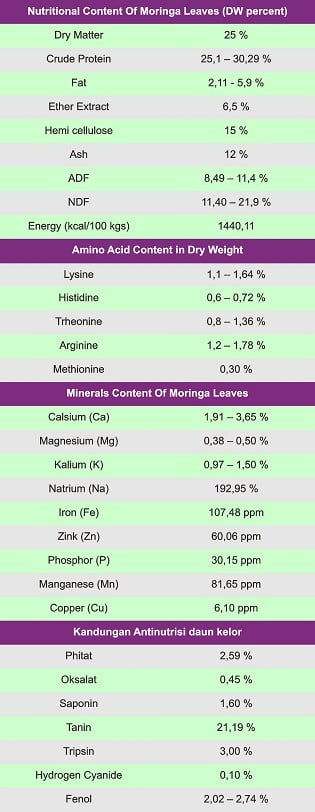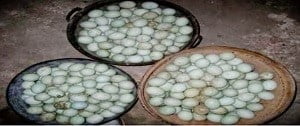Moringa oliefera for animal
Moringa leaves, can be used as feed on goat farming. This is because Moringa leaves have a high enough nutritional value to be consumed by livestock.
For example, the crude protein content of Moringa leaves is 26% of the dry matter. That amount is high enough if it used as animal feed.
However, after much investigation, the moringa leaf turns out to provide benefits for a wider range. Not only in the farming, but it extends to the field of health and even cosmetics.
For example, Moringa leaves can be used as herbal remedies for gout, cholesterol and so forth. Not only that, this Moringa leaf has also been used in products such as shampoo.
If you see the shampoo products with the composition of moringa oleifera extract, so one of its ingredients is derived from this moringa leaf.
The benefits obtained from Moringa leaves will lead to competition for its availability. Competition that occurs is whether Moringa leaves will more profitable for use in the health or as livestock feed.
Moringa plants have a fairly high forage production. It can produce buds or leaf growth fairly quickly. This is very helpful in fulfilling the supply of animal feed with high protein.
Moreover, moringa can be planted by intercropping system. In between, can be planted with other crops to increase the farmer income.
However, if it turns out that moringa leaves provides better benefits for the health sector, then farmers and breeders will prefer to choose it. Instead of using it as animal feed only.
Nutritional Content of Moringa Leaves
To use the moringa leaves in the farm, then the information to know is about the nutritional content of the moringa leaves.
According to Nureni, one of the graduates of Hasanuddin University’s Husbandry faculty in his research stated that the nutritional content in the moringa leaf is as follows:
How to get cows pregnant faster
From the information above, then moringa leaf is very good if used as animal feed. Highly crude protein content with complete amino acids can help livestock grow more quickly.
The digestibility of Moringa leaves is also quite high. Minerals contained in the leaves of Moringa is quite complete. This will be very helpful in nutrient absorption required by livestock.
Active substances of moringa leaves
Various active substances are also found in the moringa leaves. This active substance causes Moringa leaves has a myriad of benefits in the health.
All parts of this plant can be utilized. Starting from the leaves, flowers, stems, skin and roots have been widely used as a treatment material.
This is because all the active substances present in the moringa plant are scattered throughout the plant. However, the number of dissemination and concentration is different.
The content of active substances in the moringa plant is a secondary metabolite substance. This substance consists of phenols, phenolic compounds, alkaloids, and essential oils.
In addition to secondary metabolite, Moringa leaves also contain active compounds glucosinolat and isothiotianat.
The active compound is known to have a function as a hypotensive substance. Thats mean that it can improve blood pressure.
It can also function as an anti-cancer and antibacterial substances such as metabolic sekuder do.
Moringa oleifera cattle feed
As I have explained in the above paragraph, Moringa leaves have a high nutritional content. Moringa leaf, however, also has an unfavorable antinutrient substance for livestock.
Therefore, the use of Moringa leaves for cattle should not be used as a single feed.
Moringa leaf for weaning cattle weighing between 60 – 100 kg, can be given as much as 1 – 1.5% of body weight.
Giving can also be based on the presentation in the ration. The number of moringa leaves in cattle rations should be 40-60%.
With this, cows are expected to gain weight growth of 0.4 to 0.6 kg / day.
For cattle that are in its infancy, giving moringa leaves can be likened to the amount of weaning cattle.
In the hope, during the growth, the cattle will also gain weight as much as 0.4 to 0.6 kg / day.
The same is done for cows in the fattening program.
Moringa leaf granting for cows, pregnant and cow feeding is slightly different.
This is done to prevent cows do not experience obesity that will inhibit reproductive productivity.
The amount of Moringa leaves for the cow with that criterion is 0.5% of body weight or 25% in the ration.
The hope is that the increase of cow weight is not more than 0.25 kg / day. It’s aim is only to maintain the performance of the cows only.
Feeding moringa to goats
Moringa leaves that given to goats can improve the performance.
Moringa leaves can increase goat body weight, improve the digestion and absorption of nutrients to be more effective.
This is as in the research that has been done by N. Sultana et al. He is a researcher from Malaysia UPM University.
In his research, the moringa leaves given to goats in vary number.
The sex of goats used in the study was male goats. While his age, still in infancy.
In the given rations, there are different amounts of moringa leaves. The amount is 0%, 25%, 50%, & 75% even up to 100 percent.
Zero percent mean that there is no moringa leaves at all.
This is done to know the difference between goat with moringa leaves ration and goat ration without it.
Briefly, the results of his research indicate that the more amount of moringa leaves in the ration, the more of rations eaten by goats.
In addition, the highest daily weight gain is obtained by goats with a ration of 100% moringa leaves. ie as much as 61,74 grams per day.
This is because the amount of crude protein in the ration will increase with the increase of moringa leaves in the ration.
So, the conclusion is that moringa leaves is very useful to be given to goat. Even according to the research, moringa leaves can be used as a single feed in breeding goats.
Moringa chicken feed
From the many benefits of Moringa leaves, is expected to also have a positive effect on poultry farms.
As done by Nuraeni, Student of Husbandry Faculty of Hasanuddin University.
He examined the effect of moringa leaves flour on broiler chickens.
Moringa leaf flour that given to broiler chicken, it can increase the body weight, carcass weight and broiler fat abdomen decreased.
The amount of moringa flour found in the ration is 4 percent.
Moringa Fish Feed
On fishery, moringa leaves can be used as a fish feeding.
The number of moringa leaves as much as 10% in the rations, reportedly did not have a negative effect on the growth of fish.
This can save the cost of fish feed that is quite expensive if moringa leaves are obtained for free.
T. Tagwireyi, is a researcher from the University of Bindura, Zimbabwe, Africa, who examined the use of moringa leaves for use in fish feed rations.
The type of fish used in the study is tilapia (Oreochromis niloticus fry).
Before mixed into the ration of fish, moringa leaves processed first. Processing is by way of boiled and vaporized and only steamed.
Moring leaves obtained, dried first. Drying without sunlight.
After drying, then moringa leaves boiled and steamed.
Boiling and steaming is done at a temperature of 60-80 degrees celsius for 15 minutes. The goal is to reduce anti-nutritive substances in the leaves of kelor.
The best results of Moringa leaf are obtained from steamed process. Moringa leaves with the amount of 10% in the ration does not give a bad effect on the growth of tilapia.
 JOYNIM FARM Goat Farming, Cattle Farm, Laying Hens, Quail Farm, Gardening
JOYNIM FARM Goat Farming, Cattle Farm, Laying Hens, Quail Farm, Gardening





What about the Moringa seed?? Can they eat that?
Awesome website!